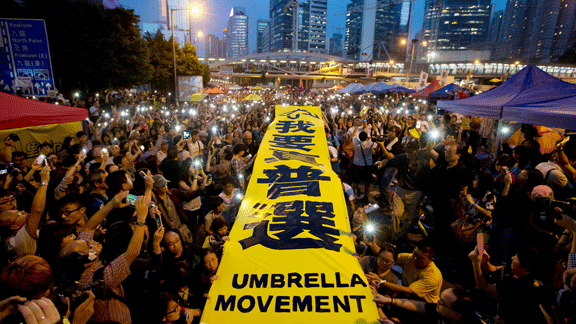Still fighting in Hong Kong

A movement for genuine universal suffrage has continued for more than a month in Hong Kong. Protesters still occupy sections of major roads in three sites: Admiralty, Mong Kok and Causeway Bay.
The week before my arrival at the beginning of October was the most intense period. The authorities had attempted to disperse the crowds with pepper spray, tear gas and triad gangsters. Cops displayed a banner reading “DISPERSE OR WE FIRE”. The violence brought up to 200,000 people to the streets on 28 September to prevent bloodshed by police.
Fortunately, no more tear gas has been used, nor have bullets been fired.
Unfortunately, none of the movement’s demands have been met. The Chinese and Hong Kong governments have ruled civil nominations for the island’s chief executive out of the question.
The current struggle has precedents. As in other countries around the world, a student movement flourished in Hong Kong during the 1970s. It built the foundation for the subsequent democratic movement. When society was politicised by the negotiation over the transfer of sovereignty from Britain to China in the early 1980s, many civil groups were quickly established and pushed the British authority to open the door to direct voting for the Legislative Council elections.
In the 1990s, many leading members of the movement were elected and they started to focus on the parliamentary struggle, rather than mobilising on the streets. The movement gradually became today’s Pan-democracy Camp.
However, after two decades of the parliamentary road, the Pan-democracy Camp has been unable to win genuine universal suffrage. The younger generation chose to go back to the streets.
Initially I thought that the Hong Kong government would clear the occupied sites within a couple of weeks. After witnessing the battle of Mong Kok I changed my mind. In the early morning of 17 October, several hundred riot police successfully removed all the barricades at Mong Kok and reopened the streets to traffic. But more than 10,000 protesters flooded into the district later in the evening and squeezed the cops out of the main road at midnight.
Nevertheless, the ultimate enemy of the protesters is the central government in Beijing, which holds an uncompromising position of maintaining its absolute authority over Hong Kong’s democratic progress.
Part of the reason for this was made clear by Hong Kong’s chief executive Leung Chun-ying, who in late October said: “Civil nomination will make politics and policies lean towards the poor.” Obviously, this statement could be applied to the rest of China. Beijing worries that if democratic rights are won in Hong Kong, the poor in Mainland will demand the same.
Hong Kong has the second largest citizen-to-police ratio in the world. And it seems that it would be almost impossible to repress the movement without bloodshed. Yet a Tiananmen Square-style confrontation would destroy the Communist Party’s legitimacy.
On the other hand, the economic impacts of the protest movement are minimal, and the supportive voices in Mainland are tiny and controllable. The Communist Party bosses might feel that they can wait patiently for the movement to disintegrate of its own accord.
That is a real danger. The protesters do not have a clear strategy to push the movement forward. The Pan-democracy Camp has left the burden of leading to the student leaders of the Hong Kong Federation of Students (HKFS). Those young women and men are courageous but politically inexperienced. They still hold illusions that lobbying the leaders of the Chinese state will prove fruitful. Their latest plan is to send a student delegation to Beijing.
The far right currents within the movement pose as the firmest defenders of the occupations, but they also don’t offer productive strategies to break the deadlock. Their primary activities are attacking the HKFS, the Pan-democracy Camp and the left wing groups.
The left in Hong Kong during the colonial era was largely controlled by Beijing, and joined the establishment after the handover in 1997. The groups formed in the new century are still too tiny to play a leading role, even though their young membership works tirelessly on the streets every day.
Nevertheless, the left has realised that the movement has to win the hearts of the working people. So they are now organising the college students to go to the poor neighbourhoods to explain how genuine democracy can be used in fighting for higher wages and lower housing prices.
A total victory is unlikely in the near future, but the umbrella movement has already made a giant impression.